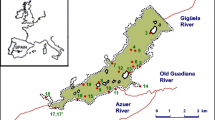Abstract
Functional groups and molecular fragments of humic substances (HSs) from cryohydromorphic peat gley tundra and surface-gley tundra soils have been identified by 13C-NMR spectroscopy. The analysis of HS preparations has shown that the molecules of humic acids (HAs) are enriched with aromatic fragments compared to fulvic acids (FAs). Aliphatic chains, carbohydrate- and amino acid-type structures prevail in the carbon skeleton of the FAs. An integrated parameter of the HS hydrophobicity has been proposed. The parameter represents the total portion of unoxidized carbon atoms and allows indirectly assessing the amphiphilic properties of HSs.
Similar content being viewed by others
References
I. B. Archegova, “Specific Features of Humus Formation in Soils of Vorkuta Tundra,” (Syktyvkar, 1972) [in Russian].
Atlas of Climate and Hydrology of the Komi Republic, Ed. by A. I. Taskaev (DiK, Drofa, Moscow, 1997) [in Russian].
A. V. Baranovskaya, “Specific features of humus formation and composition of humus in soils of the Komi ASSR,” Tr. Komi fil. Akad. Nauk SSSR. Ser. Geogr., No. 1, 113–125 (1952).
V. A. Beznosikov and E. D. Lodygin, “Fractional and group composition of humus in the cryogenic surfacegleyed and hydromorphic soils of the Bol’shezemel’skaya tundra,” Vestn. St.-Peterb. Univ., Ser. 3, No. 1, 107–120 (2012).
V. D. Vasilevskaya, Soil Formation in Tundra of Central Siberia (Nauka, Moscow, 1980) [in Russian].
Geocryological Map of the Soviet Union. Scale 1: 2.5 M, Ed. by E. D. Ershov and K. A. Kondrat’eva (Min. Geol. SSSR-Mosk. Gos. Univ., Moscow, 1998) [in Russian].
L. A. Grishina, “Specific features of organic matter in cryogenic soils,” in Problems of Soil Cryogenesis (Izd. Komi fil. Akad. Nauk SSSR, Syktyvkar, 1985), pp. 49–50 [in Russian].
M. I. Dergacheva, “Humus memory of soils,” in Soil Memory: Soil as a Memory of Biosphere-Geosphere-Anthroposphere Interactions, (Izd. LKI, Moscow, 2008), pp. 530–560 [in Russian].
B. N. Zolotareva, L. A. Fominykh, L. T. Shirshova, and A. L. Kholodov, “The composition of humus in permafrost-affected soils of the Bol’shezemel’skaya and Kolyma tundra areas,” Eur. Soil Sci. 42(1), 36–48 (2009).
E. N. Ivanova and O. A. Polyntseva, “Soils of European Tundras,” Tr. Komi Fil. Akad. Nauk SSSR, Ser. Geogr., No. 1, 72–122 (1952).
I. V. Ignatenko, Soils of the East European Tundra and Forest-Tundra, (Nauka, Moscow, 1979) [in Russian].
N. A. Karavaeva, Tundra Soils of Northern Yakutia (Nauka, Moscow, 1969) [in Russian].
The Map of Quaternary Deposits. Northern Ural Ser., Q-41-V (1: 200000), Ed. by V. S. Enokyan (Mingeo SSSR, 1959) [in Russian].
I. O. Kechaikina, A. G. Ryumin, and S. N. Chukov, “Postagrogenic transformation of organic matter in soddy-podzolic soils,” Eur. Soil Sci. 41(10), 1077–1089 (2011).
E. D. Lodygin and V. A. Beznosikov, “The 13C NMR study of the molecular structure of humus acids from podzolic and bog-podzolic soils,” Eur. Soil Sci. 36(9), 967–975 (2003).
E. D. Lodygin, V. A. Beznosikov, and E. V. Vanchikova, “Functional groups of fulvic acids from gleyic peatypodzolic soil,” Eur. Soil Sci. 34(4), 382–386 (2001).
D. S. Orlov, Humic Acids of Soils and a General Theory of Humification (Izd. Mosk. Gos. Univ., Moscow, 1990) [in Russian].
D. S. Orlov and L. A. Grishina, Practicum on Humus Chemistry (Moscow, 1981) [in Russian].
A. I. Popov, Humic Substances: Properties, Structure, and Formation (Izd. SPbGU, St. Petersburg, 2004) [in Russian].
L. A. Fominykh, B. N. Zolotareva, and D. L. Pinskii, “A comparative analysis of paleosols in ancient landscapes of northern Russia,” Kriosf. Zemli 14(2), 56–68 (2011).
V. A. Kholodov, A. I. Konstantinov, A. V. Kudryavtsev, and I. V. Perminova, “Structure of humic acids in zonal soils from 13C NMR data,” Eur. Soil Sci. 44(9), 976–983 (2011).
G. D. Chimitdorzhieva, “Specific features of the organic matter of cryogenic soils,” Pochvovedenie, No. 11, 125–132 (1991).
S. N. Chukov, Structural-Functional Parameters of Soil Organic Matter under Anthropogenic Loads (Izd. SPbGU, St. Petersburg, 2001) [in Russian].
J. W. Emsley, J. Feeney, and L. H. Sutcliffe, High-Resolution Nuclear Magnetic Resonance Spectroscopy, (Pergamon, Oxford, 1965).
J. A. Baldock and C. M. Preston, “Chemistry of carbon decomposition processes in forests as revealed by solidstate carbon-13 nuclear magnetic resonance,” in Carbon Forms and Functions in Forest Soils, Ed. by W. W. McFee and J. M. Kelly (Soil Sci. Soc. Am., Wisconsin, 1995), pp. 89–117.
J. G. Bockheim, “Importance of cryoturbation in redistributing organic carbon in permafrost-affected soils,” Soil Sci. Soc. Am. J. 71, 53–60 (2007).
X. Y. Dai, C. L. Ping, R. Candler, L. Haumaier, W. Zech, “Characterization of soil organic matter fractions of tundra soils in arctic alaska by carbon-13 nuclear magnetic resonance spectroscopy,” Soil Sci. Soc. Am. J. 65, 87–93 (2001).
B. C. Liang, E. G. Gregorich, M. Schnitzer, and H. R. Schulten, “Characterization of water extracts of two manures and their absorption on soils,” Soil Sci. Soc. Am. J. 60, 1758–1763 (1996).
K. Lorenz, C. M. Preston, and E. Kandeler, “Soil organic matter in urban soils: estimation of elemental carbon by thermal oxidation and characterization of organic matter by solid-state 13C nuclear magnetic resonance (NMR) spectroscopy,” Geoderma 130, 312–323 (2006).
J. A. Pedersen, M. A. Simpson, J. G. Bockheim, and K. Kumar, “Characterization of soil organic carbon in drained thaw-lake basins of Arctic Alaska using NMR and FTIR photoacoustic spectroscopy,” Organic Geochem. 42, 947–954 (2011).
C. M. Preston, “Applications of NMR to soil organic matter analysis: history and prospects,” Soil Sci. 161, 144–166 (1996).
A. J. Simpson, J. Burdon, C. L. Graham, M. H. B. Hayes, N. Spencer, W. L. Kingery, “Interpretation of heteronuclear and multidimensional NMR spectroscopy of humic substances,” Europ. J. Soil Sci. 52, 495–509 (2001).
R. S. Swift, Methods of Soil Analysis (Soil Sci. Soc. Am., Madison (WI), 1996), Part 3, pp. 1018–1020.
Author information
Authors and Affiliations
Corresponding author
Additional information
Original Russian Text © E.D. Lodygin, V.A. Beznosikov, R.S. Vasilevich, 2014, published in Pochvovedenie, 2014, No. 5, pp. 546–552.
Rights and permissions
About this article
Cite this article
Lodygin, E.D., Beznosikov, V.A. & Vasilevich, R.S. Molecular composition of humic substances in tundra soils (13C-NMR spectroscopic study). Eurasian Soil Sc. 47, 400–406 (2014). https://doi.org/10.1134/S1064229314010074
Received:
Published:
Issue Date:
DOI: https://doi.org/10.1134/S1064229314010074



